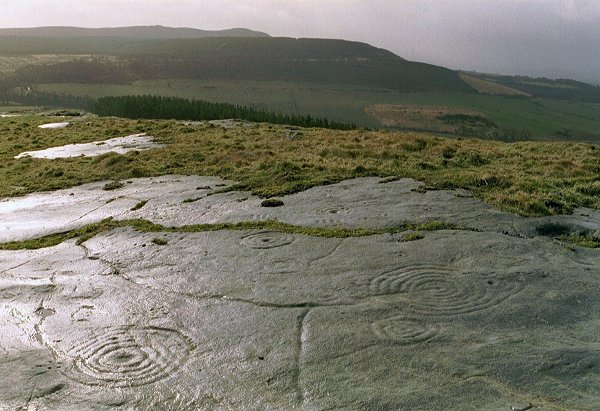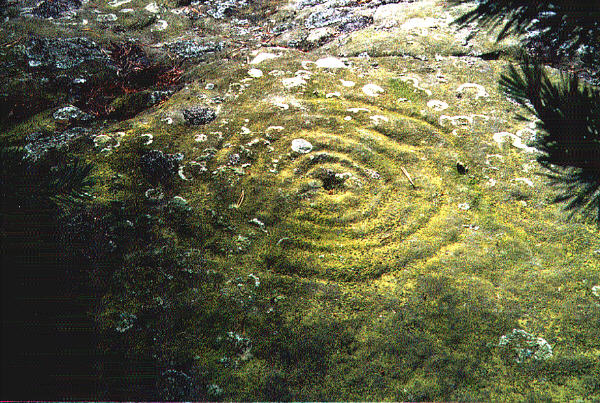

A closer look at the Glebe Stone. March 2003.

The Glebe Stone seen from the SE with two doubtful cup-marks. March 2003

South of the chamber (see arrow) is a greywacke slab which might have been a cover-slab. On it is a very weathered and partly flaked-off cup and five rings.

A very faint cup and five rings on a almost flat laying stone on the left side behind the facade. The carving can only be seen in the right sunlight around noon, after wetting the stone with (local!) water. The last black&white photo of the carving was published -as “Cairnholy 2”- in Ronald W.B. Morris’ book “Rock Art of Galloway & The Isle of Man” (Blandford, 1979), p. 74.
Don’t forget to get your coffee in the Milfield Country Cafe and enjoy a small information stand about the history of the area and/or buy there Cliff Waddington’s very informative booklet “Land of Legend, Discovering ancient Northumberland”.
Over the years there has been some confusion over the rock art location ‘Whitsun Bank’ probably caused by the fact that the two locations are situated about 500m apart. Whitsun Bank 2 is on outcrop rock (former quarry) in a field along the road, 280 deg. from the gate opposite the entrance to Fowberry Farm. Whitsun Bank 1 is 500m West of Whitsun Bank 2 and consists of lesser and smaller motifs. A very nice area so take your time!
We saw these small carvings for the first time in 1999. They are set on outcrop rock in the heather on the right site of a track from Coldmartin Loughs Main to the triangulation pilar, just before the wire fence.

On this outcrop rock (former quarry) you’ll find a cup with two rings and three outrunning grooves, resembling the motif on the big stone of Weetwood Cairn.

This is what stone 13a looked when we finaly found here! See next pic’s for the surprise!

The cup and ring on stone 13a if it was pecked out yesterday!

Detail of the uncovered part of stone 13a

Barningham Moor, stone 13a.

Barningham Moor, site 3.

View to the site from the North

View over the outcrop rock with two carvings to the West.

A small carving, nicknamed ‘the sause pan’, North of the main panel.

A pear-shaped groove around cups; part of the main panel.

Cups enclosed by rectangular grooves and outrunning groove; a part of the main panel.

A view over the main panel with the pear-shape in the foreground. The carvings are on three different levels.

Ancient rock art in perfect balance with the surrounding landscape. What more can you ask for?

A rainy morning on Chatton Park Hill creating the right atmosphere for deep thoughts!

A place to remember on this ‘Country File’ Sunday, 16th of March 2003!

OK Pebblethief, you asked for it and here we are; two Dutch sitting ducks. Make that Grouses for obvious reasons! Yes, it were our foot- or eyebrow prints you saw. And as always; the Badger came later. Lets keep the good memories!

In our view one of the nicest rock art panels in the UK; Ketley Crag, North of Chatton Park Hill.

Detail of the decorated stone near Monzie’s stone circle.

Lordenshaw, the Horse-shoe Rock, just W of the main rock on an embankment.

This is one of the motifs which make this rock art location one of the finest in the UK. There are more great photos of this motif in this TMA collection but on this one you may clearly notice the “rays” for which it is known (at least to us!) as “the bebop”.

Weetwood Moor, site 1; crossed halter-cups.

Weetwood Moor, site 1; on the edge of the former quary.

Weetwood Moor, site 6 (on the E. side of the plantation, just behind the wire fence). August 1998.

Weetwood Moor, site 3; the main panel is marked by a pile of stones. August 1998.

Weetwood Moor, site 3; detail of the rock art panel. The out-running groove doesn’t cut through the rings.

Weetwood Moor, site 5 (in the Gorse bush), with a pear-shaped cup-and-ring motif. Photo by Gus, May 2002.















